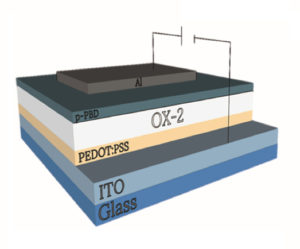Eco-MOFs

Metal-organic frameworks (MOFs) are advanced materials made from metal ions connected by organic linker molecules. MOFs can be designed from different metals and linkers to target specific end-use applications.
Commercially attractive applications are light-emitting or luminescent MOFs (LMOFs) powered sensors for Volatile Organic Compounds (VOC), biomarkers and photonic devices. The current production of MOFs is not eco-friendly. It is currently a long complex process using toxic solvents (N, N-dimethylformamide, methanol) in harsh high temperature and pressure environments.
Green and up-scalable production
Researchers at the University of Oxford have developed a fast method of producing large amounts of MOF material. This uniquely eco-friendly method uses water as a solvent and allows processing at room temperature and pressure. The method has been applied to produce a specially designed MOF- a highly emissive silver metal-based LMOF, invented and named as OX-2 by Oxford.
The resultant silver-based LMOF detects changes in temperature and pressure and functions as the electroluminescent layer of a LED device without toxic and expensive rare-earth elements.
This is a high-yield method to produce10-g of high- quality silver-based LMOFs in under an hour, using cost-effective and environmentally friendly water solutions of silver nitrate and terephthalic acid. The estimated cost is about 1000 times cheaper than commercially produced MOFs, an advantage of processing in ambient conditions and employing water as a solvent.
The technology
When subjected pressure (up to 0.3 GPa) and temperature (up to 200°C), the Oxford silver-based LMOF shows a dramatic decrease of the luminescence response. Its linearly reversible and reproducible thermochromic response is attractive for use in applications such as a luminescent thermometer and its mechanochromic response to pressure is promising for use as a luminescent surface stress sensor.
An Oxford MOF prototype LED device integrating OX-2 as the electroluminescent layer has been designed and fabricated (see image above).
Commercial advantages of Oxford technology:
- Eco-friendly, fast, high-yielding, cost-effective, and patent-protected production methodology
- Oxford OX-2 class of silver-based LMOF gives high luminescent quantum yield (60% in powder form) with long-term stability
- Devices with OX-2 provides a linear, repeatable, and reproducible thermochromic response in luminescent thermometers
- Devices with OX-2 provides a luminescent response to nominal stress deformation-based sensors
- Devices with OX-2 provides electroluminescent properties fabrication of LEDs which are free of toxic and expensive rare-earth elements
Commercialisation
Oxford University Innovation Ltd. has filed a patent covering this technology and is now seeking an appropriate commercialisation partner.
Support is available to prospective commercialisation partners. Oxford researchers are advancing the development of processing techniques for newly discovered target MOFs. A proof of concept programme is underway to design and develop a prototype VOC sensor suitable for industrial toxic VOC detection and diabetes diagnostics in healthcare.
about this technology

